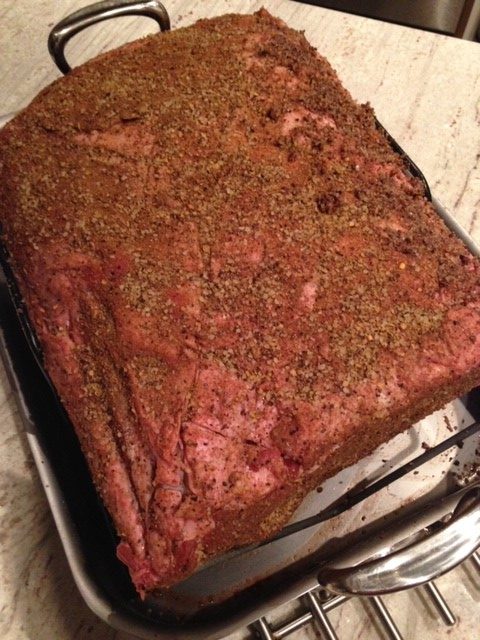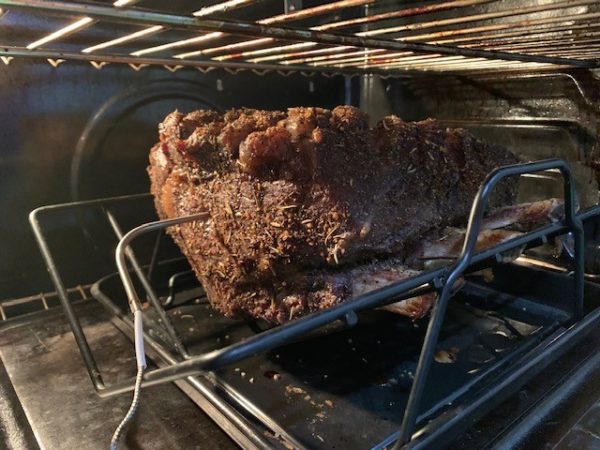One of my most favourite things to cook is a prime rib, especially when it’s on sale! It’s dead simple to make! To make the perfect prime rib, you will only need a meat thermometer and…time…In this post, I’d like to show you my ultimate way to cook prime rib from the various ways I’ve done it in the past and provide some of my thoughts and experiences as well.
If you know me, you’ll know that I love to sous vide. The challenge with sous viding prime rib is that the prime ribs I generally buy are larger than the plastic bags that are available to vacuum seal.
There are many recipes online on making the ultimate prime rib, here is my ultimate recipe.
Background: If you look online, there are various methods out there, each have their pros and cons:
| Method | Pro | Con |
| Sous Vide | No need to have a meat thermometer
Smallest gradient between the crust and the medium-rare interior out of all methods Cannot overcook it |
Need a sous vide machine
Need vacuum sealer Larger prime ribs roasts cannot fit in a plastic bag to vacuum seal No delicious smell because it’s trapped in a vacuum sealed bag |
| Closed Oven Method | Quickest method
No need to have meat thermometer Smells delicious while it cooks |
There’s (simple) math involved
Largest gradient between the crust and the medium-rare interior |
| Reverse Sear | Smells delicious while it cooks
Small gradient between the crust and the medium-rare interior |
Takes a lot of time (inactive cooking)
Need to have a meat thermometer No drippings to make gravy |
As you can tell, the sous vide method is probably the least favorable as it requires the most amount of equipment. The closed oven method is good, but does not provide the best results. So that’s why I say the reverse sear method is the ultimate method – below is my recipe.
To get started, here are a few things to consider:
Size: the size of the prime rib, you can estimate one bone for to feed about two people. For example, if you’re feeding 8 people, get a 4-bone prime rib. You’ll probably have some leftover, but I don’t think anybody will be complaining about that.
Temperature: Depends on how done you would like the prime rib, but my favourite is medium rare, which my magic internal temperature is 131 degrees.
Take out the prime rib when it reaches internal temp of 125 degrees, then as the roast rests, it will continue to climb to ~131 degrees
 Prep: 3 days before:
Prep: 3 days before:
- Season the prime rib with your favourite seasoning, honestly you cannot go wrong here, don’t be scared of using too much salt, as the roast is so big, it’s fine.
- If you would like to know what I put in mine, feel free to reach out to me directly
- Optional: Remove the bones so that it is separated from the roast, then after it is all seasoned, you can tie it back together by using butcher’s twine
- The reason why you would want to do this is so that when the roast is completely done, you don’t need to struggle cutting through and holding a hot prime rib if you don’t feel comfortable with it.
- Once the prime rib is all seasoned, put it back into the fridge, uncovered, this will help draw out some of the moisture from the roast, and when it roasts, it’ll form a really nice crust
Day of:
 Take out the prime rib 2 hours before you want to begin roasting
Take out the prime rib 2 hours before you want to begin roasting
- For reference, a 4-bone prime rib, will take about 6 hours to roast at 170 degrees in the oven.
- Turn the oven to 200 degrees (or the lowest your oven can hold the temperature – my oven can go down as low as 170 degrees, so that’s what I use)
- Put the roast on a wire rack on rimmed baking tray, insert meat thermometer
- Some recipes will recommend using a roasting pan. However, I would recommend against it because the walls of the roasting pan will actually prevent the air flow getting underneath the roast.
- Take out the prime rib when it reaches internal temp of 125 degrees and cover it loosely with aluminum foil. As the roast rests, it will continue to climb to ~131 degrees
Searing the Prime Rib: While the roast is resting, you can pump up your oven to the highest temperature (500 degrees F). When your guests arrive, you can put the roast back into the oven for about 5 minutes, or however long it takes to get the crust crispy – so you’ll need to keep an eye out on this. Once you’re satisfied with the crust, you can take it out and slice it!
 For perfect medium rare prime rib, put prime rib into a 200 degree oven until the roast reaches an internal temperature of 125 degrees, take it out, and cover in foil, the internal temp will continue to rise till around 130 degrees. As the roast is resting, turn up your oven to as hot as it can (500 degrees?). Once at temp, place the roast back in and leave it in for about 5 minutes – all you want is just a crust. Once it looks good, take it out, slice it up and serve!
For perfect medium rare prime rib, put prime rib into a 200 degree oven until the roast reaches an internal temperature of 125 degrees, take it out, and cover in foil, the internal temp will continue to rise till around 130 degrees. As the roast is resting, turn up your oven to as hot as it can (500 degrees?). Once at temp, place the roast back in and leave it in for about 5 minutes – all you want is just a crust. Once it looks good, take it out, slice it up and serve!
